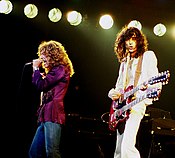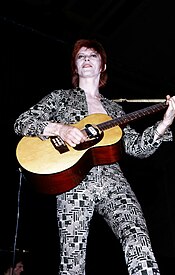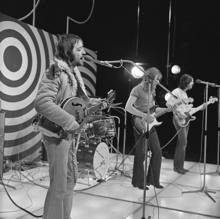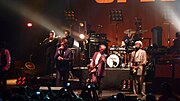Music of the United Kingdom (1970s)
| 1970s in music in the UK |
|
|
| Events |
|---|
Popular music of the United Kingdom in the 1970s built upon the new forms of music developed from
Rock
Progressive rock

Progressive or 'prog rock' developed out of late 1960s
British rock mainstream

Some British rock bands that began their careers in the British Invasion 60s, notably The Rolling Stones, The Who and The Kinks, also developed their own particular styles and expanded their international fan base during 1970s, but would be joined by new acts in new styles and subgenres.[4]
UK mainstream rock was often derived from
Hard rock and Heavy metal
This section needs expansion. You can help by adding to it. (April 2010) |

The
From the late 1960s the term heavy metal began to be used to describe some hard rock played with even more volume and intensity.
Glam rock

Glam or glitter rock was developed in the UK in the post-
British folk rock

British folk rock was developed in Britain during the mid to late 1960s by the bands
Pub rock
Punk rock
Punk rock developed between 1974 and 1976, originally in the United States, where it was rooted in
Post punk

During the second half of the 1970s and early 1980s musicians identifying with or inspired by Punk rock also pursued a broad range of other variations, giving rise among others to the post-punk movement. The genre retained its roots in the punk movement but was more introverted, complex and experimental.[25] Post-punk laid the groundwork for alternative rock by broadening the range of punk and underground music, incorporating elements of Krautrock (particularly the use of synthesisers and extensive repetition), Jamaican dub music (specifically in bass guitar), American funk, studio experimentation, and even punk's traditional polar opposite, disco, into the genre.
During 1976–77, in the midst of the original UK punk movement, bands emerged such as Manchester's Joy Division, The Fall, and Magazine, Leeds' Gang of Four, and London's The Raincoats that became central post-punk figures. Some bands classified as post-punk, such as Throbbing Gristle and Cabaret Voltaire, had been active well before the punk scene coalesced;[26] others, such as The Slits and Siouxsie and the Banshees, transitioned from punk rock into post-punk.
New wave

As the initial punk impulse began to subside, with the major punk bands either disbanding or taking on new influences, the term new wave began to be used to describe particularly British bands that emerged in the later 1970s with mainstream appeal. These included pop bands like
Synth rock
Many progressive rock bands had incorporated synthesisers into their sound, including
Pop
This section needs expansion. You can help by adding to it. (April 2010) |

The early 1970s were probably the decade when British pop music was most dependent on the group format, with pop acts, like rock bands, playing guitars and drums, with occasional additions of keyboard or orchestration. Some of these groups were in some sense "manufactured", but many were competent musicians, playing on their own recordings and writing their own material. In addition to the glam and glitter rock bands who enjoyed considerable success in the early 1970s. Aiming much more for the teen market, partly in response to US pop groups were
Folk music
Perhaps the finest individual work in the genre was from artists early 1970s artists like
British soul/jazz
Industrial music
Industrial music was an experimental music style, often including electronic music, that drew on transgressive and provocative themes. The term was coined in the mid-1970s to describe Industrial Records artists. It blended avant-garde electronics experiments (including tape music, musique concrète, white noise, synthesisers, sequencers) and a punk sensibility.[43] The first industrial artists experimented with noise and controversial topics. Their production was not limited to music, but included mail art, performance art, installation pieces and other art forms.[44] Prominent industrial musicians include the Sheffield based groups Throbbing Gristle and Cabaret Voltaire.[44] While the term was initially self-applied by a small coterie of groups and individuals associated with Industrial Records, it broadened to include artists influenced by the original movement or using an industrial aesthetic.
Jamaican music

See also
- 1970s in music
- Music of the United Kingdom (1950s)
- Music of the United Kingdom (1960s)
- Music of the United Kingdom (1980s)
- Music of the United Kingdom (1990s)
- Music of the United Kingdom (2000s)
Notes
- ^ a b c d e "Glam Rock Music Genre Overview". AllMusic. Retrieved 8 January 2021.
- ^ a b "New Wave Music Genre Overview". AllMusic. Retrieved 8 January 2021.
- ^ a b c "Prog-Rock/Art Rock". AllMusic. 2007. Retrieved 4 December 2007.
- ^ J. Atkins, The Who on record: a critical history, 1963-1998 (McFarland, 2000), p. 11.
- ^ J. M. Curtis, Rock eras: interpretations of music and society, 1954–1984 (Popular Press, 1987), p. 236.
- ^ P. Buckley, The Rough Guide to Rock (Rough Guides, 3rd edn., 2003), p. 378.
- ISBN 0-88284-473-3, pp. 37–38.
- ^ Graeme Thomson (13 May 2010). "Kate Bush's only tour: pop concert or disappearing act? The Guardian 13 May 2010". The Guardian. London. Retrieved 29 May 2010.
- ^ "Kate Bush | Biography, Albums, Streaming Links". AllMusic. Retrieved 8 January 2021.
- ^ D., Weinstein, Heavy Metal: The Music and its Culture (Da Capo, 2000). p. 14.
- ^ a b "Hard Rock", Allmusic, retrieved 11 November 2009.
- ISBN 0-7935-4042-9, p. 113.
- ISBN 0-8195-6260-2, p. 7.
- ISBN 0-8195-6260-2, p. 10.
- ISBN 0-8195-6260-2, p. 3.
- ^ "Glam Rock". Encarta. Archived from the original on 13 January 2005. Retrieved 21 December 2008.
- ^ M. Brocken, The British Folk Revival, 1944–2002 (Aldershot: Ashgate, 2003).
- ^ a b c d B. Sweers, Electric Folk: The Changing Face of English Traditional Music (Oxford: Oxford University Press, 2005).
- ^ J. S. Sawyers, Celtic Music: A Complete Guide (Cambridge MA: Da Capo Press, 2001), pp. 1–12.
- ^ "Pub Rock- Pre Punk music". Punk77.co.uk. Retrieved 8 January 2021.
- ^ L. D. Smith, Elvis Costello, Joni Mitchell, and the Torch Song Tradition (Greenwood, 2004), p. 132.
- ^ "Pub Rock Music Genre Overview". AllMusic. Retrieved 8 January 2021.
- ^ P. Murphy, "Shine On, The Lights of the Bowery: The Blank Generation Revisited", Hot Press, 12 July 2002; Hoskyns, Barney, "Richard Hell: King Punk Remembers the [ ] Generation", Rock's Backpages, March 2002.
- ^ a b c d "British Punk Music Genre Overview". AllMusic. Retrieved 8 January 2021.
- Allmusic. Retrieved 2 November 2006.
- ^ Reynolds (2005), p. xxi.
- ^ P. Buckley, The rough guide to rock (London: Rough Guides, 3rd edn., 2003), p. 801.
- ^ a b P. Gambaccini, T. Rice and J. Rice, British Hit Singles (6th edn., 1985), pp. 335–7.
- ^ E. Macan, Rocking the classics: English progressive rock and the counterculture (Oxford: Oxford University Press, 1997), pp. 35–6.
- ^ "The Man Who Dies Every Day - Ultravox | Song Info | AllMusic". AllMusic. Retrieved 8 January 2021.
- ^ J. Miller, Stripped: Depeche Mode (Omnibus Press, 2004), p. 21.
- ^ "Synth Pop Music Genre Overview". AllMusic. Retrieved 8 January 2021.
- ^ B. Longhurst, Popular Music and Society (Wiley-Blackwell, 1995), p. 245.
- ^ E. Vincentelli, ABBA Gold (Continuum, 2004), p. 50.
- ^ S. Brown, Marketing: the Retro Revolution (SAGE, 2001), p. 131.
- ^ P. Buckley, The Rough Guide to Rock: the definitive guide to more than 1200 artists and bands (London: Rough Guides, 2003), pp. 145, 211–12, 643–4.
- ^ "Streets Of London, Ralph McTell", BBC Radio 2, Sold on Song, 19 February 2009.
- ^ "Biddu: Futuristic Journey & Eastern Man". Dutton Vocalion. Archived from the original on 28 September 2011. Retrieved 8 July 2011.
- ^ James Ellis. "Biddu". Metro. Retrieved 17 April 2011.
- ^ W. Kaufman, H. Slettedahl Macpherson, Britain and the Americas: culture, politics, and history (ABC-CLIO, 2005), pp. 504–5.
- ^ A. Blake, The land without music: music, culture and society in twentieth-century Britain (Manchester: Manchester University Press, 1997), p. 149.
- ^ E. Macan, Rocking the classics: English progressive rock and the counterculture (Oxford: Oxford University Press US, 1997), p. 132.
- ^ "Industrial Music Genre Overview". AllMusic. Retrieved 8 January 2021.
- ^ a b V.Vale. Re/Search #6/7: Industrial Culture Handbook, 1983.
- ^ P. Childs and M. Storry, Encyclopedia of Contemporary British Culture (Taylor & Francis, 1999), p. 496.
- ^ W. Kaufman and H. S. Macpherson, Britain and the Americas: culture, politics, and history (ABC-CLIO, 2005), p. 818.
- ^ K. Walker, Dubwise: Reasoning From the Reggae Underground (Insomniac Press, 2005), p. 205.
- ^ A. Donnell, Companion to contemporary Black British culture (London: Taylor & Francis, 2002), p. 185.
